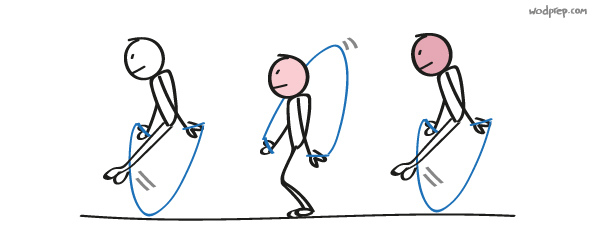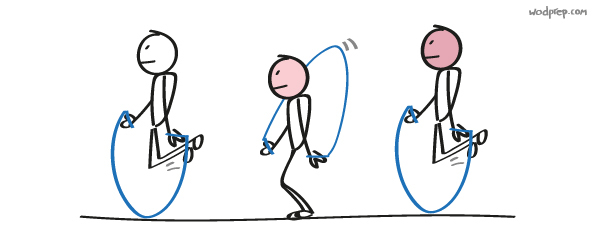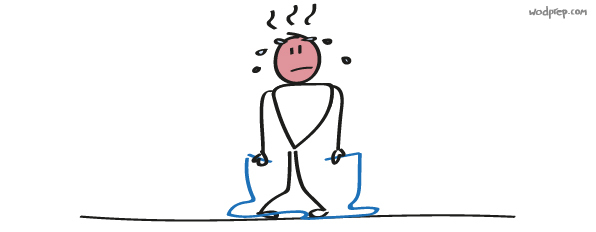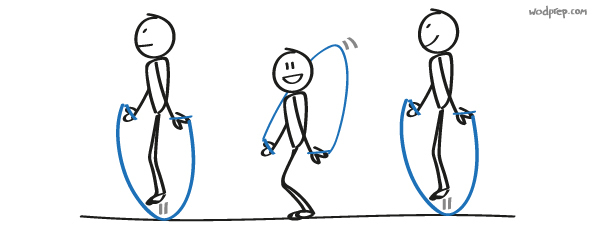Let’s face it - there’s a lot more that goes into double unders than just swinging a rope around and jumping. So I want to take a second to talk through something that may seem simple, but is super important...
Double Under Jumping Form
When most people string together their first few unbroken reps, they default to double under jumping styles that aren’t necessarily energy efficient. Not to mention, they can make you look absolutely ridiculous.
Let’s take some time to look at the two biggest mistakes...
Double Under Jumping Error #1
The pike jump. This is when someone jumps and keeps their legs locked out and straight, with their feet pointed. A pike jump also forces the feet forward, so that basically the entire body is slightly folding forward in order to rebound, instead of remaining straight up and down.
This may be due to some kind of unexplained idea that bringing your feet forward help to avoid the rope that’s passing under… which isn’t actually the case.

In truth, there is barely any height difference at all when comparing a pike jump to the correct double under jump form (which I’ll get to a little further down) - the feet actually come up to about the same level above the ground in both cases.
And the downside is, piking is very inefficient. It creates a ton of unnecessary forward and backwards movement, wasting your precious energy during a workout.
Double Under Jump Error #2:
The donkey kick. This is what I call a double under jump when I see athletes lifting their feet up behind them, and tucking them towards their butt.

The reason why someone might default to this is again, the thought process of the higher you bring your feet, the more clearance for the rope. Makes sense, however it’s again a huge waste of energy, specifically for your hamstrings.
On top of that, donkey kicking sets you up to be in a bad landing position. You don’t just jump straight up and down with a donkey kick, your feet are also moving back and forth.
It may give you some extra of hang time, but the extra exertion just isn’t worth it.

OK, so then what is the proper double unders jump form?
It’s what I call the ‘pogo stick position’.
Compare all the extra movement described above to the more compact pogo stick jump, which keeps your legs and feet underneath your center of gravity. It’s simply a smoother movement. Pogo stick jumping should keep you in a vertical position, with a slight bend at the hips as well as the knees.
This type of double under jump also helps you absorb yourself back into the spring, so that when you jump up the spring extends, and when you come back down the spring loads.
(Think: body position transitioning from a straight line, to a bendy line)

An added plus is that the pogo stick jump form allows you to land with more brace and control, as well as less noise.
Good DU jumping form = softer landing = less stress on your body.
Don’t get me wrong, jump height is also an important factor when it comes to double unders. If you find yourself pogo stick jumping, but still tripping on the rope, try switching back to single-unders, and practicing a slightly higher jump.
Take a big jump, and pass the rope under your feet once. This helps to mimic the rhythm of a double under jump with the correct form, so that all you need to do moving forward is increase your wrist speed.
These may seem like tiny, nit-picky details, but they truly do make a difference when it comes to bettering your double unders and becoming more efficient. Take some time to study what your double under jump form looks like, and adjust as necessary.
Looking for more double under tips? Head here to learn more about our 8-week Double Unders course - Double Unders Unleashed.
Be sure to leave us a comment and let us know what your biggest double under sticking points are. We're here to help!

Great post – I love the visuals
Thanks Colin! Hope they help… 🙂
I do the same thing – Visuals, I can animate them for you: https://youtu.be/i8XfFykvwAM
I’m a donkey kicker!!! 🙂 Thanks for the pointers/tips, I’m so close to stringing together decent double unders, and I know my form is holding me back so this is perfect.
You’ve got this! Keep practicing, and let us know if you have any questions!
Thanks Coach Ben! You and your team are amazing!! I’m looking into getting some gear from you soon 🙂
For the double under landing, do the feet land more towards the midfoot or closer to the toes when hitting the ground? Thank you again for your excellent tips!
Hey Ada – you should be landing on the balls of your feet – so not on your toes, but right behind them… if you land too far back it might start shifting your weight backwards 🙂
Thanks Ben
Followed your free course but didn’t pay enough attention to form. Practiced after every WOD and got to 10-12 consecutive DUs but had to stop due to knee/hamstring strain. More donkey kick than pogo stick!!! Back to penguin jumps and big singles until I fix my jump!
Good luck – you got this! Like you said – take a step back and really focus on that jumping form, I bet you’ll see progress 🙂
You’ve got this, Cam! Form is very, very important with all of these movements and will definitely help prevent injuries!
Can you make a tutorial on the clean? Exercises that help to correct form?
Hey Barbara – we will definitely keep that in mind for future posts! In the meantime, we have a handful of videos on clean technique as well – https://www.youtube.com/watch?v=1_IK2yYA3ig&list=PLUQKM1VYgdVdYe3xbvm27Nt1Cjd9qqc3Z
So embarrassed to say this but it bothers me so much. When do DUs, I wet my pants…. how can I fix this
Hey – not embarrassing at all! This is actually super common, but also not ‘normal’ when it comes to your body. There are ways to help fix it – our coaches recommend checking with a physical therapist or a pelvic floor specialist. Lastly, here’s a great article that can speak to the issue further, and give you some ideas as to how to help 🙂
https://drjohnrusin.com/peeing-during-workouts-not-normal/
First of all: I love the WodPrep content. It is great. On DUs, however, I miss one thing which was my big ‘mistake’, the issue because of which I was not able to do many DUs without being exhausted very early: you need to spin the rope fast and you need to have the consistent strength to do that, just out of your wrists. After having practiced a lot – how to jump, hold the rope, body tension, blabla… and became completely frustrated, I met a lady from China who used to be a professional rope jumper (yes, these people exist). She made videos of me trying DUs and identified the issue: the rope is spinning way too slow. I am training with heavy ropes now to fix this and make good progress
Christian – thanks for sharing your story! Different things work for different athletes – awesome that you were able to find some DU help (and how cool that she was actually a professional jump roper….). I hope that your progress continues with the heavy ropes! 🙂
Any tips on how I can progress from the ‘penguin drill’ to double unders? I have the penguin drill down, have been practising ‘power jumps’ every day and totally get the premise behind it but as soon as I pick up the rope it doesn’t translate to a single double under. 200+ single unders in a row are no issue but I am whipped to shreds from constantly trying and failing to get dubs.
Hey Becca!
Chances are your penguin clap might not be as accurate as you might think. I’ve worked with several athletes that think the Penguin Clap is easy, but then I show them a couple way they might be doing it incorrectly.
To be honest, it is quite hard to do too much coaching when I’m not able to see a video of the movements. I’d highly suggest checking out our double under coaching course, Double Unders Unleashed (https://wodprep.com/double-unders-unleashed/ ) and then you’ll get to work directly with the WODprep team to finally get double unders once and for all!
[…] Frequent causes of landing weird are donkey kicking, or pike jumping. We actually have a whole article on how to fix your jumping here. […]